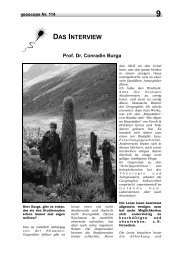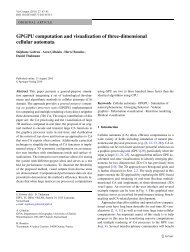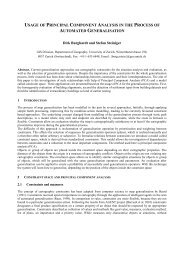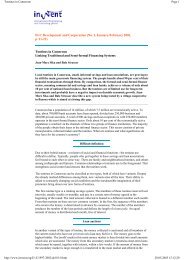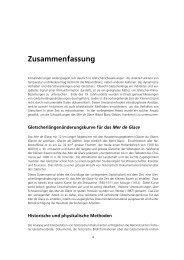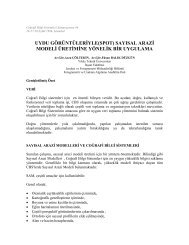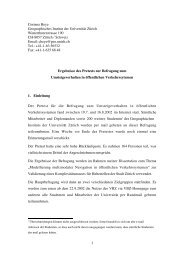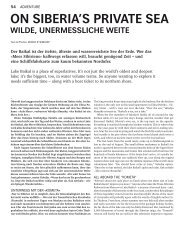Pedogenesis of Chernozems in Central Europe — A review
Pedogenesis of Chernozems in Central Europe — A review
Pedogenesis of Chernozems in Central Europe — A review
Create successful ePaper yourself
Turn your PDF publications into a flip-book with our unique Google optimized e-Paper software.
292 E. Eckmeier et al. / Geoderma 139 (2007) 288–299<br />
Table 1 (cont<strong>in</strong>ued)<br />
Authors Soil name Location Climate Vegetation Time Man Fire<br />
As given by FAO-WRB Precipitation/ Soil Uncerta<strong>in</strong> Steppe Forest– Forest Late Holocene<br />
authors<br />
evaporation,<br />
temperature<br />
water<br />
teppe Glacial<br />
Roeschmann Schwarzerde Chernozem/<br />
Bas<strong>in</strong><br />
Lower Saxony x x x x<br />
et al. (1982)<br />
Phaeozem<br />
Sabel (1982) Tschernosem Chernozem/<br />
Phaeozem<br />
Hesse x x –– –– ––<br />
Schönhals et al. Brauner Rhe <strong>in</strong>tal– Phaeozem Upper Rh<strong>in</strong>e x x<br />
(1982) Tschernosem<br />
Valley<br />
Donau–<br />
Chernozem/ Romania x x<br />
Tschernosem Phaeozem<br />
Mückenhausen Tschernosem Chernozem/ Germany x x x<br />
(1985b)<br />
Phaeozem<br />
Thiemeyer Tsche rnosem– Phaeozem Hesse x x x x<br />
(1989) Parabraunerde<br />
Thater and Stahr Parabr aunerde– Phaeozem Suebia x x x x<br />
(1991) Tsche rnosem<br />
Gehrt et al.<br />
(1995)<br />
Grauerde Phaeozem Lower Saxony x x<br />
Ehwald et al. Schwarzerde Che rnozem <strong>Central</strong> x x x x<br />
(1999)<br />
Germany<br />
Fischer-Zujkov Parabraunerde– Phaeozem Uckermark x x x<br />
et al. (1999) Tschernosem<br />
(Schmidt et al.,<br />
1999, 2002)<br />
Chernozemic soil Germany –– –– –– –– –– –– –– x<br />
(Schmid et al., Archaeological<br />
Bavaria x x<br />
2001, 2002) soil<br />
Scheffer/ Tschernosem Chernozem/ Germany x x x<br />
Schachtschabel<br />
(2002)<br />
(Schwar ze rde) Phaeozem<br />
Authors (selection) <strong>in</strong> chronological order. X = yes, ––= no, () = uncerta<strong>in</strong>.<br />
(Szücs, 1963), <strong>in</strong> the Vojvod<strong>in</strong>a (Neigebauer et al., 1983), <strong>in</strong><br />
Bohemia and Moravia (Hrasko et al., 1973), <strong>in</strong> the Pannonian<br />
Bas<strong>in</strong> <strong>of</strong> Eastern Austria (Franz, 1955; F<strong>in</strong>k, 1956; Blum and<br />
Solar, 1986), <strong>in</strong> the East <strong>of</strong> Poznan <strong>in</strong> Poland (Hohenste<strong>in</strong>,<br />
1919) and <strong>in</strong> the <strong>Central</strong> German Dry Area (e.g. Czerny, 1965;<br />
Altermann and Mania, 1968).<br />
Phaeozems can be found <strong>in</strong> different varieties and do not<br />
appear <strong>in</strong> a def<strong>in</strong>ed area (FAO-UNESCO, 1981). We could not<br />
record all areas covered by the patchy distributed Phaeozems, or<br />
their spatial extent had to be exaggerated to show their<br />
appearance <strong>in</strong> Fig. 2. In Germany they occur <strong>in</strong> loess-covered<br />
regions, <strong>in</strong>clud<strong>in</strong>g Lower Saxony (Scheffer and Meyer, 1963;<br />
Bailly, 1972; Roeschmann et al., 1982), Rhe<strong>in</strong>gau and<br />
Rhe<strong>in</strong>hessen (Hohenste<strong>in</strong>, 1920; Harth, 1956; Zakosek, 1962;<br />
Leser and Maqsud, 1975; Zakosek, 1991), near Stuttgart and<br />
Heilbronn (Müller, 1951), Westphalia (Hohnvehlmann, 1963;<br />
Wichtmann, 1965), Lower Rh<strong>in</strong>e Bas<strong>in</strong> (Kopp, 1965; Schalich,<br />
1981), Lower Hesse (Haupenthal, 1978), Uckermark (Fischer-<br />
Zujkov et al., 1999) and the Wetterau Bas<strong>in</strong> (Altmannsberger,<br />
1971). Phaeozems can be found <strong>in</strong> the Limagne bas<strong>in</strong> <strong>in</strong> France<br />
(FAO-UNESCO, 1981; ISSS, 1996) and <strong>in</strong> alp<strong>in</strong>e dry-valleys<br />
(Meyer, 1926; Frei, 1980; Blum and Solar, 1986; ISSS, 1996).<br />
In warm and dry Swiss alp<strong>in</strong>e valleys, Phaeozems with mollic<br />
epipedons occur <strong>in</strong> altitudes between 600 and 1700 m a.s.l.<br />
They usually formed on a mixture <strong>of</strong> well dra<strong>in</strong>ed calcareous<br />
and silicate parent material, like mora<strong>in</strong>es (Frei, 1980). Soils on<br />
the island <strong>of</strong> Poel (Baltic Sea) were classified as soils with<br />
phaeozem-like properties. They have dark mollic A horizons<br />
developed on sandy, not on silty loess-like parent material<br />
(Albrecht and Kühn, 2003). Similar soils can be found on the<br />
island <strong>of</strong> Fehmarn (Schimm<strong>in</strong>g and Blume, 1993) (Table 1).<br />
4. Time <strong>—</strong> When did <strong>Central</strong> <strong>Europe</strong>an <strong>Chernozems</strong><br />
form?<br />
Late Glacial and Early Holocene were discussed as possible<br />
times <strong>of</strong> <strong>Central</strong> <strong>Europe</strong>an Chernozem pedogenesis (Kopp,<br />
1965; Ehwald et al., 1999). Stratigraphical methods and radiocarbon<br />
dat<strong>in</strong>g were used to determ<strong>in</strong>e the age <strong>of</strong> a soil. But<br />
methodological problems, and because the ages vary over time,<br />
absolute ages are still not known.<br />
4.1. Stratigraphical and palaeoecological evidence?<br />
The possibility <strong>of</strong> a formation <strong>of</strong> <strong>Chernozems</strong> <strong>in</strong> the Late<br />
Glacial was supported by the occurrence <strong>of</strong> steppe conditions<br />
that were regarded as requirement for their development<br />
(Wilhelmy, 1950; Kopp, 1965). Proceed<strong>in</strong>g from west to east,<br />
the warmer and more humid climate <strong>in</strong> the Early Holocene<br />
stopped the accumulation <strong>of</strong> humus material (Kopp, 1965). This<br />
view was encouraged by observations <strong>of</strong> relics <strong>of</strong> fully<br />
developed Chernozem found at archaeological sites related to






